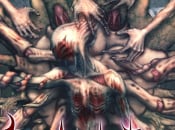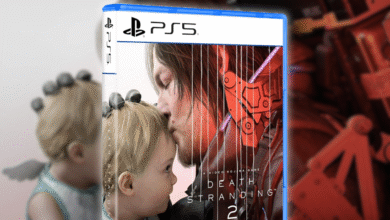Review: Angel At Dusk (Switch)


Indie developer Akiragoya doesn’t just want you to get better at their latest shmup Angel at Dusk. They want to improve your prospects across the entire genre. Though taking a glance at the new Switch port of their distinctly grotesque work, you’d be forgiven for thinking the opposite is true.
Set deep in a future where pleasure, sin, crime, and more have been eradicated by scientific progress, Angel at Dusk presents an aggressive arcade bullet-hell shooter built around a meticulously repulsive futuristic body horror theme. The levels are formed from tangled masses of pustulating body parts, held together by ribbons of glistening sinew – an aesthetic that carries over to the monstrous enemy craft. Most moments through the game’s various modes, meanwhile, are filled with dense, intense bullet curtains, while elaborate intersecting mechanical systems focus on high-risk play. Hypercasual or cosy, Angel at Dusk is not.

And yet with their recent creation – first released to PCs earlier this year – Akiragoya may have delivered one of the most welcoming examples of true arcade-aggressive bullet hell yet realised, all without ostracising devoted players already literate in the language of shmups. Ultimately, Angel at Dusk is a strikingly intelligent game, across its design, writing, wit, and understanding of what traditional shooting games are. It knows enough of the rules of shmup design to know exactly which ones to break – without ever breaking the formula of authenticity.
Over time numerous developers have made amicable attempts at cracking open arcade shooters for the masses – but in the cases of works like Cuphead and CYGNI, while bringing many merits, they arguably deviate so far from the arcade tradition that they propose very different experiences indeed. Angel at Dusk, meanwhile, serves up an utterly authentic arcade shooter resplendent in complex intersecting game and scoring systems, deeply rewarding intense action, and overwhelming swarms of gaudy ordinance, with a soundtrack entirely unafraid to rattle your very core with musical forms like free jazz. It is every bit authentic, and yet its doors are wide open to a vast sweep of players.

That is evident in the magnificently detailed – and entirely optional – opening tutorials, which take you from the very basics of movement over a 2D plane, to high-level techniques such as ‘figure-of-eight weaving’; a method of bullet navigation that can get you through all manner of boss patterns across the genre.
So how has Akiragoya achieved all this? It’s time to return to that former point about knowing which rules to break. Angel at Dusk makes no effort to boldly reinvent the genre, nor add elaborate new systems. Instead, two subtle tweaks to convention have been made that deliver a profound difference without being unnecessarily disruptive. You can bump into enemies without taking damage, and you can earn a steady drip feed of extra lives.
Stated so directly, those two changes don’t seem too remarkable. But they immaculately complement the game’s core risk-reward system. Shoot enemies up close, and green heart items shower down, steadily filling an HP bar. Top out that HP bar, and you get an extra life; something possible several times per stage in most cases. As such, to survive a full clear of the game, you’ll want to put yourself right up in the grill of those repugnant foes. As such, it is remarkably helpful that collisions don’t do your ship any damage. But in charging up to rivals, you’ll still be putting yourself right amongst those bullet hell patterns at the very moment they are at their densest.

All of which means you have to shoot point-blank to earn lives to survive, which in and of itself puts you in the game’s most dangerous spots. And so it is that genre newcomers and veterans alike are encouraged to play deeply aggressively and experience the joy of trading risk for reward.
The Arcade and Story modes take a conventional form, providing five linear vertical stages, each topped with a boss. Arcade insists you pick a ship with a set weapon loadout, while Story lets you mix your own blends of wide-shot, laser, press-and-release bullet-cancelling barrage, and so on. Then there’s Chronicle mode, which lets you move through a branching path structure, opening up new level and boss variants, as well as fresh weapon options. Open a stage in Chronicle mode, and you can return to it at any point thereafter, without having to play the previous levels, making it perfect for shorter sessions. Be warned though, Chronicles get very hard indeed.

In Arcade mode, meanwhile, the default ‘very hard’ difficulty setting can be one-credit-cleared (1CC’ed) first time fairly easily if you’ve spent years with the genre, while novices will very likely overcome it with a little investment of time. But just as you feel smug for triumphing over Angel at Dusk, it playfully refers to that ‘very hard’ setting as its own ‘very easy mode’; but rest assured the next setting up presents plenty of challenges for shmup aficionados.
Interestingly, Angel at Dusk might be better described as a ‘systems shmup’ rather than a ‘scoring shmup’, because while there are cunning ways to score well – namely though Raiden Fighters Jet-informed medal chaining – largely it comes to playing well enough to eradicate as many foes as possible. To do that you must explore all the intersecting play systems you can over becoming familiar with one central scoring mechanism.
Beyond the proximity focus, there’s EXP collecting that lets you level up your craft on the fly, reducing hitbox size and adding an increasingly powerful missile barrage to the period when you are charging your secondary weapon. Across Chronicle and Story modes there’s also a fairly intricate system of upgrading and customising weapon loadouts, while some ships sport bombs that can be earned from those green power-ups.

There is a lot to learn, but Angel at Dusk does a splendid job of explaining and communicating its inner workings. Which takes us back to that ambitious tutorial, which demonstrates a deep knowledge of the entire genre, as well as a playful willingness to lovingly mock some of the form’s more absurd conventions, all while eagerly encouraging the player. The tutorials are pock-marked by some minor slip-ups in translation, but in this wonderfully odd game, those mistakes add to the otherworldly poetic flair that gives the tutorial its voice. Indeed, ‘tutorial’ might not say enough, because Angel at Dusk’s guide to play also most stands as an essay on shmup design; a besotted treatise to why the genre is so wonderful, and how an arms race between players and developers has birthed one of the most rewarding forms gaming has ever offered.
The body horror – grotesque throughout and even unsettlingly sexualised in moments – might be a bit much for some. But this is a game that plays, looks, and sounds remarkable. It performs tremendously on the whole too, though in docked mode we spotted occasional stuttering in the moments between stages.
Ultimately, Angel at Dusk has a bounty to offer players of every skill level, and it excels in something so many otherwise exquisite shmups fail at. It’s empowering, even if you haven’t touched a 2D shooter in your life.
Conclusion
Angel at Dusk is wonderful, weird, and built on a foundation of deep understanding of the genre, and an intelligence and self-awareness that elevates its potential to delight. Not all will take to its theme, but it presents a deeply authentic hardcore bullet hell experience, a dazzling wit, and a suite of game systems that are a joy to explore. And the fact it welcomes a wide range of players to an authentic shmup? It’s one of the year’s most enticing genre contributions.


